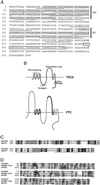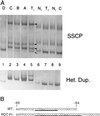The hereditary renal cell carcinoma 3;8 translocation fuses FHIT to a patched-related gene, TRC8
- PMID: 9689122
- PMCID: PMC21380
- DOI: 10.1073/pnas.95.16.9572
The hereditary renal cell carcinoma 3;8 translocation fuses FHIT to a patched-related gene, TRC8
Abstract
The 3;8 chromosomal translocation, t(3;8)(p14.2;q24.1), was described in a family with classical features of hereditary renal cell carcinoma. Previous studies demonstrated that the 3p14.2 breakpoint interrupts the fragile histidine triad gene (FHIT) in its 5' noncoding region. However, evidence that FHIT is causally related to renal or other malignancies is controversial. We now show that the 8q24.1 breakpoint region encodes a 664-aa multiple membrane spanning protein, TRC8, with similarity to the hereditary basal cell carcinoma/segment polarity gene, patched. This similarity involves two regions of patched, the putative sterol-sensing domain and the second extracellular loop that participates in the binding of sonic hedgehog. In the 3;8 translocation, TRC8 is fused to FHIT and is disrupted within the sterol-sensing domain. In contrast, the FHIT coding region is maintained and expressed. In a series of sporadic renal carcinomas, an acquired TRC8 mutation was identified. By analogy to patched, TRC8 might function as a signaling receptor and other pathway members, to be defined, are mutation candidates in malignant diseases involving the kidney and thyroid.
Figures





References
-
- Cohen A J, Li F P, Berg S, Marchetto D J, Tsai S, Jacobs S C, Brown R S. N Engl J Med. 1979;301:592–595. - PubMed
-
- Li F P, Decker H J, Zbar B, Stanton V P, Jr, Kovacs G, Seizinger B R, Aburatani H, Sandberg A A, Berg S, Hosoe S. Ann Intern Med. 1993;118:106–111. - PubMed
-
- Latif F, Tory K, Gnarra J, Yao M, Duh F M, Orcutt M L, Stackhouse T, Kuzmin I, Modi W, Geil L, et al. Science. 1993;260:1317–1320. - PubMed
-
- van den Berg A, Buys C H. Genes Chromosomes Cancer. 1997;19:59–76. - PubMed
-
- Ohta M, Inoue H, Cotticelli M G, Kastury K, Baffa R, Palazzo J, Siprashvili Z, Mori M, McCue P, Druck T, et al. Cell. 1996;84:587–597. - PubMed
Publication types
MeSH terms
Substances
Associated data
- Actions
- Actions
Grants and funding
LinkOut - more resources
Full Text Sources
Other Literature Sources
Medical
Molecular Biology Databases
Research Materials

